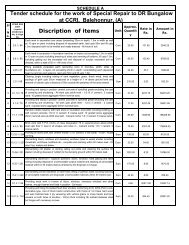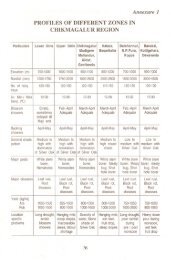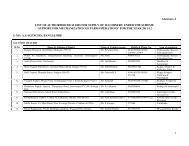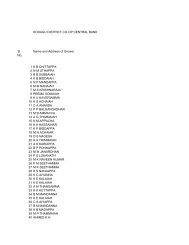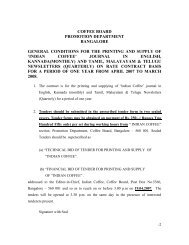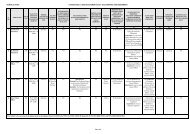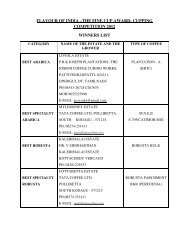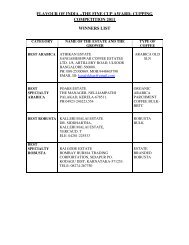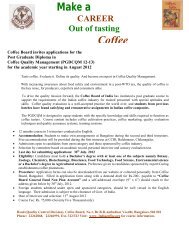COFFEE CULTIVATION GUIDE - Coffee Board of India
COFFEE CULTIVATION GUIDE - Coffee Board of India
COFFEE CULTIVATION GUIDE - Coffee Board of India
Create successful ePaper yourself
Turn your PDF publications into a flip-book with our unique Google optimized e-Paper software.
8<br />
To prepare cherry c<strong>of</strong>fee, fruits should be picked as and when they are ripe.<br />
Greens and under ripe fruits should be sorted out and dried separately. All the<br />
extraneous matters like twigs and leaves should be separated from the fruits and dried.<br />
The fruits should be spread uniformly in the drying yards at a thickness <strong>of</strong> 7 – 8 cm.<br />
Clean cement or clay lined drying yards should be used for drying the cherry c<strong>of</strong>fee.<br />
Use <strong>of</strong> cow dung smeared or mud drying yards should be avoided. Drying c<strong>of</strong>fee in<br />
such yards causes mould formation in cherry c<strong>of</strong>fee and quality <strong>of</strong> such c<strong>of</strong>fees is<br />
very inferior. <strong>C<strong>of</strong>fee</strong> should be stirred and ridged at least once every hour to facilitate<br />
uniform drying. In the evening time cherry c<strong>of</strong>fee should be heaped and covered with<br />
polythene or tarpaulin sheets to avoid contact with the mist. The c<strong>of</strong>fee will be fully<br />
dry in about 10 -12 days under the bright weather conditions. Cherry c<strong>of</strong>fee should be<br />
dried to a moisture level <strong>of</strong> 12 to 12.5%. The cherry is dry when handful <strong>of</strong> the drying<br />
cherry produces rattling sound when shaken and a sample forlit records the same<br />
weight on two consecutive days. At the end <strong>of</strong> the harvest, the remaining fruits on the<br />
plants should be completely stripped and fallen fruits should be gleaned cleanly. If<br />
this method <strong>of</strong> complete stripping and gleaning is not followed, there is a danger <strong>of</strong><br />
<strong>C<strong>of</strong>fee</strong> Berry borer infestation during the coming years. Stripped and gleaned c<strong>of</strong>fee<br />
should be dried separately and should not be mixed with other c<strong>of</strong>fee.<br />
4. <strong>C<strong>of</strong>fee</strong> effluent management<br />
Letting out <strong>of</strong> untreated c<strong>of</strong>fee effluent to natural water streams or to open lands is<br />
environmentally unsafe as it causes water and land pollution. Use <strong>of</strong> untreated c<strong>of</strong>fee<br />
effluent for irrigation is also prohibited by the law. Since, c<strong>of</strong>fee processing coincides<br />
with the dry season when amount <strong>of</strong> water present in the natural streams is at the<br />
minimum, causing further concern <strong>of</strong> higher degree <strong>of</strong> pollution.<br />
The c<strong>of</strong>fee effluents emanating from the pulper units are highly acidic and contains<br />
high amounts <strong>of</strong> dissolved and suspended biodegradable organic matters. These<br />
effluents, if discharged into natural water bodies without treatment, pollute the<br />
receiving bodies by depleting dissolved oxygen present in it. Polluting natural water<br />
bodies will have an adverse effect on domestic users, aquatic life, livestock and water<br />
course down the stream. The pollution load <strong>of</strong> c<strong>of</strong>fee effluent is measured in terms <strong>of</strong><br />
Biological Oxygen Demand (BOD) and Chemical Oxygen demand (COD).<br />
Depending on the quantity <strong>of</strong> water used to process one unit <strong>of</strong> clean c<strong>of</strong>fee (1 M.T),<br />
the BOD and COD amounts vary in the effluent. The amount <strong>of</strong> BOD range between<br />
8000 and 13,000 ppm and the COD levels will be around two times <strong>of</strong> the BOD<br />
present in the effluent. One should note that BOD levels will increase if pulped water<br />
is recycled during the processing.<br />
In order to protect the environmental health and to control the pollution on<br />
account <strong>of</strong> polluted water reaching the natural water bodies, agricultural land and<br />
open spaces, Central Pollution Control <strong>Board</strong> (CPCB), Government <strong>of</strong> <strong>India</strong> has<br />
imposed certain laws and guidelines for handling effluents. These guidelines have to<br />
be followed mandatorily failing which the person is severely punishable under the<br />
law. As per the CPCB statute, the water to be used for irrigation should not contain<br />
more than 100 ppm <strong>of</strong> BOD and water to be discharged to natural water bodies should<br />
not contain more than 30 ppm <strong>of</strong> BOD. Since, c<strong>of</strong>fee effluent contains more than the<br />
stipulated levels <strong>of</strong> BOD and COD, it has to be treated by following recommended<br />
methods <strong>of</strong> treatment before use in the field or discharging it to the streams.<br />
8



